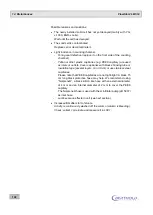
FlowStar2 LB 514
14. Disturbances
123
14.3 Luminescence Effects
This chapter summarizes all those effects which cause a signal in the ra-
dioactivity channels even though no radioactivity is present in the measur-
ing cell. The spectral distribution (channel ratio) indicates the cause. De-
pending on the spectral distribution, the following phenomena may occur:
Message: "
High Luminescence
" in the status window.
apparent or ghost peaks
unquiet and increased BG line, with luminescence warning
unquiet and increased BG line, with additional outliers, spikes
rising rate with some purely organic solvents; this effect usually occurs
with a rising flow rate and decreases when turning off the flow rate (de-
cays very slowly; decay time may be up to one hour).
Luminescence refers to light events occurring so often that they cannot be
compensated any more by the coincidence circuit and, consequently, may
disturb the measurement process in the measuring cell. These single pho-
ton events occur mainly in the low-energy channel but cause no interfer-
ence in the high-energy channel with increased lower level LL = 050 to
100:
Phosphorescence
Some organic solvents are excited by external light and emit the accumu-
lated light in the cell.
Remedy:
Keep solvent in a dark container, cover transparent supply lines (e.g. Tef-
lon) by black foil.
ACN Step Gradient
With acetonitril-buffer-gradients in the range 60 - 80% acetonitril concen-
tration. A ghost peak may occur if a step gradient is used in this range. The
effect occurs with solid cells as well as with the admixture method. The
cause is that the acetonitril is not completely mixed with the buffer behind
the column. Streaks are visible.
Remedy:
Select a less steep gradient curve.








































